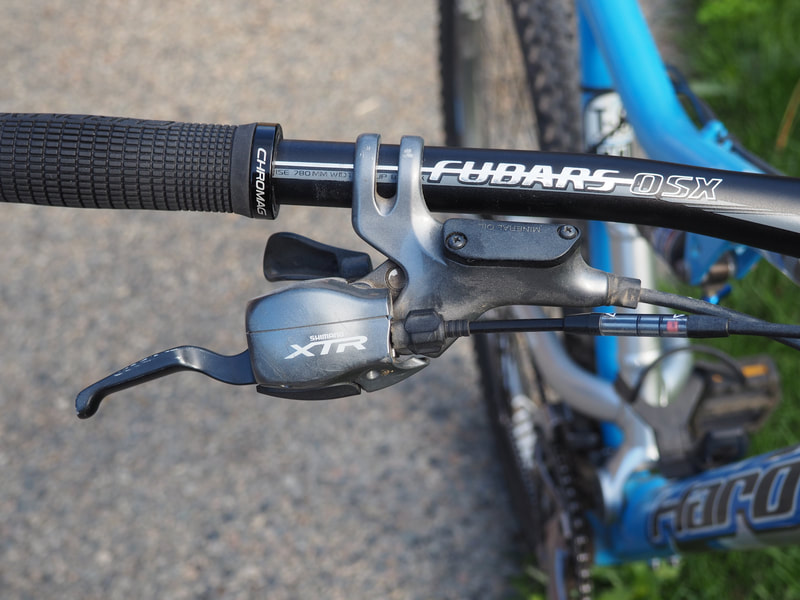But this, I just had to have...
The main course, of course, is a full XTR group; brakes, wheels, shifters, and the best looking cranks ever made. And the price was nuts. There's someone selling a Santa Cruz Superlight with some basic LX type parts for three times what I paid for this. I just couldn't pass it up.
Also I once had the entry-level version of this bike, the XLS 1.0, and I loved it. It feels like I got my old bike back with some serious upgrades.
Now, this bike has a couple features that I've recently been thinking about; Shimano's failed Dual Control shifters, and failed RapidRise derailleur. If you are unfamiliar with these wonderful units, allow me to explain.
I don't know for certain, but what I remember is that this was Shimano's attempt at creating an off-road version of their highly successful STI brake/shift levers on their road bikes. Why not right?
Well, there's a problem. Fingers are really good at gripping. The muscles in your hand are strong when you make a fist. But when you try to do the opposite, they are not strong. At all. So, pushing up on the lever is tough. On top of this, when the brake lever is in the correct position, which is rotated pretty far down, you're really stuck with just your finger tips under that lever, trying to push it up.
Shimano tried to solve the problem with this big thumb paddle there, which definitely made it easier, but nobody involved liked this setup. Riders, mechanics - nobody. I'm pretty sure it only lasted two years.
On top of this screwball shifter, this bike also features a RapidRise derailleur. Every other derailleur made starts out on the smallest cog on the cassette. The shifter pulls the cable, dragging the derailleur "up" to the easiest gear. This is actually a "downshift," since you're going to a lower gear ratio, but my mind has always seen it as going up the cogs. I should probably try to break this habit.
The point was to make the shifters for front and rear affect the same change to the riding experience, rather than do the same phyiscal thing to the derailleur. Before RapidRise, the thumb paddle on both front and rear shifters dragged the chain to bigger chainrings or cogs. In the front, this made it harde to pedal. In the rear, it made it easier to pedal. RapidRise made it such that the right side thumb paddle dragged the chain to a smaller cog, making it harder to pedal. The thinking behind this was that beginners would find it easier to understand shifters if "thumb paddle = faster" was the case on both sides of the bar.
I started working at Redbike just as these shifters came out, but I really don't remember complaints about them. I found a blog saying that mechanics at the time just hated them, and if shop guys didn't like them, they wouldn't be recommending them to buyers.
I'm cool with the DualControl shifters. They're not the best things I've ever used, but they make shifts quickly and accurately. My problem is RapidRise. It's quite common when trail riding that you'll encounter an unexpected hill, and you need a lower gear now. And not just a lower gear, but a much lower gear. With old thumbshifters, just slam that thing forward with your thumb. Shimano took those away though, so the best you could do with RapidFire was slam that thumb paddle forward for three quick downshifts and hope it was enough.
With DualControl your instinct is to slam down on the brake lever for those three quick downshifts - it makes sense to me that pulling the cable drags the derailleur to a larger cog for a lower gear ratio. Except no, that gets you three quick upshifts thanks to RapidRise. Instead you need to spam the thumb paddle, or click the brake lever up as fast as you can before you hit that hill.
It's not a surprise that RapidRise failed really. Sure it may have made sense conceptually to a beginner, but any established rider looking to upgrade would have hated the experience. At least until they remembered every time they got on their RapidRise bike that it went the other way from all their other bikes. Way easier to just ditch it.
I'm just going to ride it and have fun. I got a top of the line race bike - that's 17 years old - for less than the price of a decent entry-level trail bike. No way that's ever a mistake.





 RSS Feed
RSS Feed
